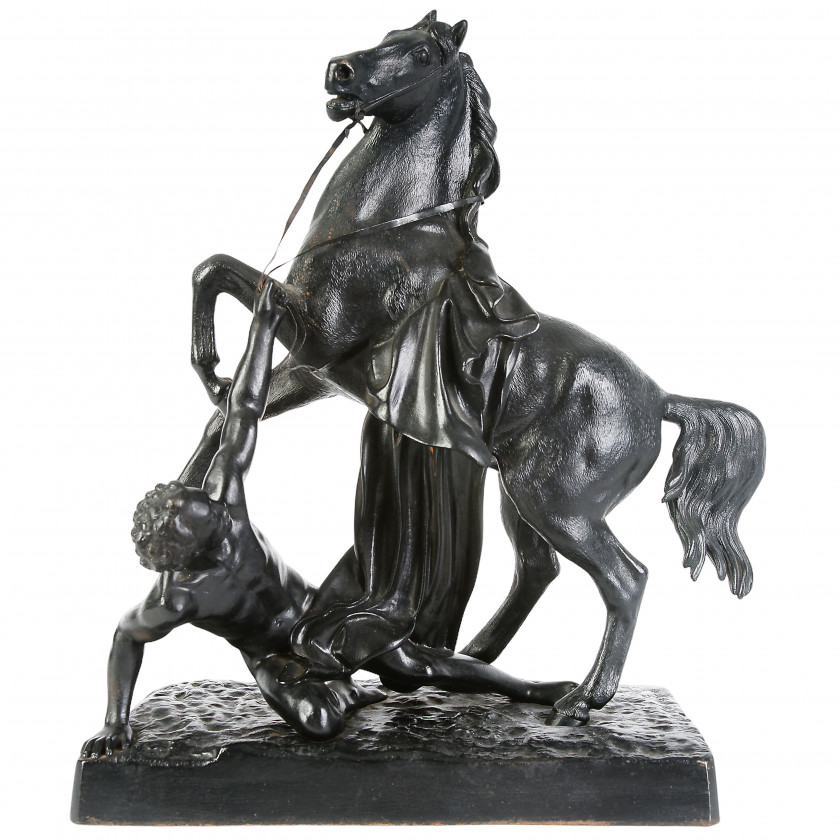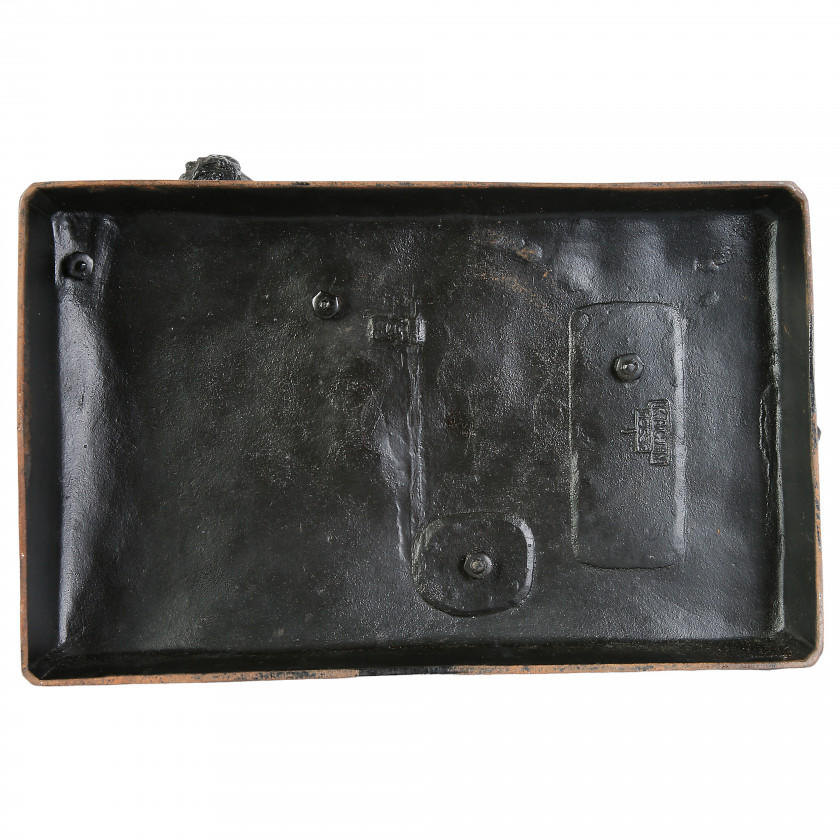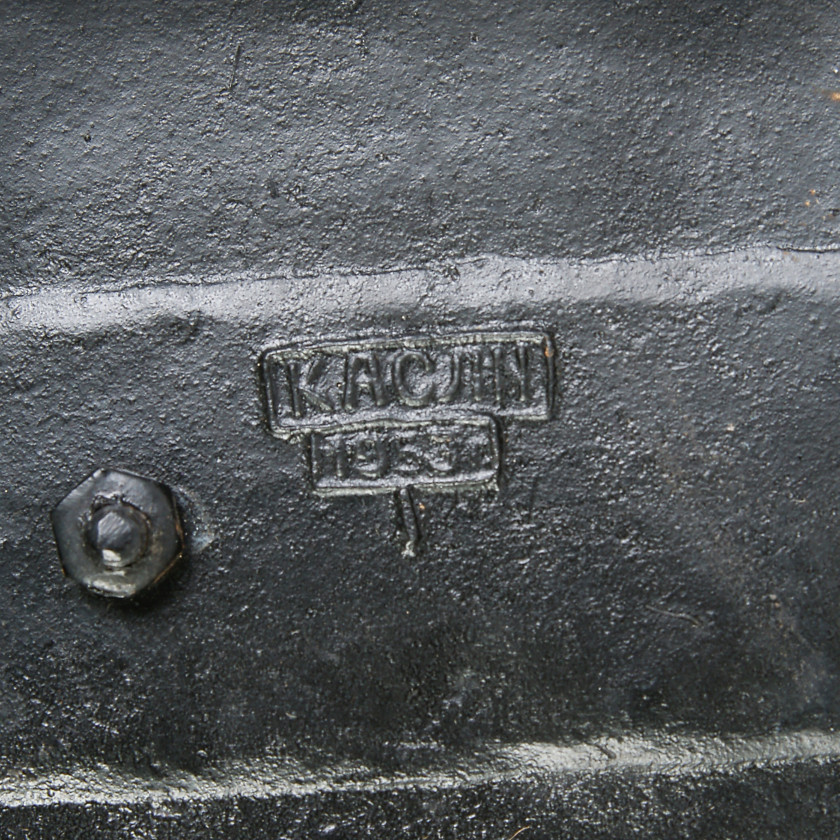Sculpture "Horse with the fallen rider"
-
Item has been sold
Artist/Maker: Kasli cast-iron castings foundry, according to the model of P. K. Klodt
Artist/Maker Dates: 1747 - present
Place of Production: Russia (USSR), Kasli
Date of Production: 1953
Materials: cast-iron, paint
Width: 32.0 cm.
Depth: 19.5 cm.
Height: 42.0 cm.
Condition:
Condition notes: Wear consistent with age and use
Description
Located in the Urals in the city of Kasli, Chelyabinsk region. The place for the plant establishing was determined not without reason. The Urals region was rich in cast iron and large deposit of unique high-quality foundry sand was available in Kasli. Moreover, a huge amount of wood for blast furnaces was around the town. Thus, one direction of folk artistic crafts - manufacturing of multifarious art products from cast iron got its name due to the plant location.
Cast sculptures, applied and decorative art items, objects for architectural decoration – those were the products, made in the Kasli casting technique.
The 1746th was the year when Kasli plant development began. A merchant from Tula, Yakov Korobkov, laid the foundation stone to the foundry. In 1751, he sold the manufacture to Nikita Demidov. Substantial reconstruction and the production facility broadening was realized under the Demidov’s family. By the end of the 18th century, Demidov rebuilt the blast furnace; constructed four modern brick buildings instead of three wooden ones. New managing director - Grigori Fedorovich Zotov, was appointed in 1823. The evolvement of artistic casting was associated with his activities. The German castings that G.F. Zotov brought from Berlin were the first patterns for Kasli masters. They quickly acquired the German technology of artistic casting implementing moulding in sand form, made innovations modifications and successfully used this technology for casting various statues, busts, sculptural groups and other products. Thus, Kasli art casting emerged in 1824.
G.V. Druzhinin, being a passionate collector of paintings, art bronze and porcelain - one of the managing directors, bought up all best sculptural pieces, regardless of the material in which they were executed (metal, porcelain, wood, gypsum, etc.) in the capital's antique shops. He also acquired the right to replicate works from the best Russian sculptors and made special orders for manufacturing models for casting. Besides, Druzhinin provided many items from his vast collection of artistic bronze and porcelain for casting in iron, for example, more than 20 works of the academician of sculpture P.K. Clodt, which became gold standards of casting in Kasli.
Since the 1860s, the production of indoor casting started to be made by order, active search for stylistics and products’ assortment was put into practice, and the set of models was constantly replenished. The plant actively participated in exhibitions in St. Petersburg, Nizhny Novgorod, Paris, London and other towns. The applied arts school for training new masters was opened within the framework of the Kasli plant.
The quality of cast iron items was constantly improved, and the Kasli plant gained the worldwide fame. In the middle of the 19th century, cast iron products by the Kasli plant were awarded with Small Gold Medal at exhibitions in London and Paris. It was an extremely important and significant fact in the plant history, and its products’ position on the world markets strengthened significantly. The works of Russian sculptures were sample pieces for castings – works by F. Tolstoy. E. Lanceray, N. Lieberich; and V. Simonov, N. Tomsky, M. Manizer, V. Mukhina - in the 20th century. The period from the middle of the1880s through to 1914, was the Golden age of Kasli art casting, its production reached its peak, all major Kasli sculptures were crated in that time. During this period, Kasli art castings were second to none in Russia and in the world as well.
The Kasli plant received the highest award at the All-Russian Exhibition in Nizhny Novgorod in 1896, - the right to put the State Emblem of Russia, the two-headed eagle, on its products.
This success became the prelude to the total triumph at the 1900 Paris Exposition - the Kasli plant site, which was presented as the openwork cast-iron pavilion, received the highest award – Large Gold Medal. A huge palace-shaped pavilion in the Byzantine style was cast from iron by the artisans from Kasli as presentation of their production skills. E. Baumgarten realized the project. Cast iron openwork palace received the highest award -Grand Prix.
The pavilion was opened all round the clock. Kasli masters earnestly answered questions, presented the visitors with small cast iron souvenirs. One of the visitors (the American citizen) took away as a keepsake just a piece of metal. The major element of the exposition pavilion was the sculpture called "Russia" (by the sculptor Nikolay Laveretsky), depicting a woman in military attire. The products of the plant were declared the foundry art masterpieces. Large number of the Kasli exposition visitors were eager to become the owners of the pavilion. However, authorized persons refused to sell the “Russia” statue. As a result, the “warlike lady” returned to its homeland.
Unfortunately, the gloomy military times began in the Russian Empire. World War I, Civil War and October Revolution took place at the beginning of the 20th century. Shattering experience in the economy and financial situation had corrosive effect on the casting business development, the longstanding artisanship started to varnish.
It should be noted that after the October revolution, in 1922-1928, a short-run series of Kasli castings with revolutionary implication was produced at the plant: busts of revolutionaries, small statuary and various houseware items. Special workshop for artistic and architectural casting was created in 1934. It was fully refined, updated, expanded and modernized in the late 80s of the 20th century. The workshop’s managers had a task to update the subject matter of art products in order to reflect modern times. Since 1935, the factory had been realizing orders for large-size architectural castings (urban art lanterns, elements for embankments and bridges, park fencing, urban benches, trash bins, etc.).
During the Second World War, the plant worked for the front. Almost lost art craft and unique collection were reconstructed painstakingly in subsequent years. The cast iron pavilion restoration was started in 1957. It lasted almost eight months. The pavilion has several entrances and is composed of a huge number of various ornamental cast elements, wonderfully integrated.
In 1978, UNESCO included the Kasli plant in the list art memorials of global importance.
Nowadays, one can acquaint with the incredible works of cast-iron artisanship in the Fine Art museum in Yekaterinburg. Products of Kasli artisans are stored in various Russian towns. The Kasli casting is distinguished by clear silhouette, subtlety of openwork patterns, accuracy of surface finishing and color purity. Following the traditional technology, contemporary artisans use special composition of cast iron. After annealing, the castings are processed manually by embossing in order to convey the surface texture. Thus, foundry molds obtain the accomplished form and look.
Shipping details
- Log in to see the cost for shipping this lot to your address.
Shipping methods are determined by item size, type, fragility and specific characteristics.
Shipping costs are calculated based on carrier rates, delivery distance and packing complexity.
Payment details
Doma Antikvariāts accepts the following payment methods:










